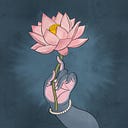A Folio from “Isarda” Bhāgavata Purāṇa
Kṛṣṇa’s Vastrāharaṇa Līla
This manuscript of the Bhāgavata Purāṇa is admired for its sophistication, its animated narration, and above all, its sheer joie de vivre. This painting captures the essence of the text, which describes Krṣṇa’s vastrāharaṇa līla. Krṣṇa is seated in a tree, having stolen the robes of the women that had come to bathe in the river. The episode is set in the month of Mārgaśīrṣa, during which, early every morning, the young gopis would take one another’s hands and, singing of Kṛṣṇa’s transcendental qualities, go to the Yamunā to bathe. Desiring to obtain Kṛṣṇa as their husband, they undertook a vrata would then worship the goddess Kātyāyanī with incense, flowers and other items. The semi-dressed gopis surrender to Krṣṇa with bhakti, passionately expressed in the manuscript painting. One day, while the gopis were bathing, the dark lord takes the girls’ garments and climbs the kadamba tree on the banks of the Yamuna. He only returns them when they surrender to him, and realise that they had been transgressing their austere vrata by bathing in the river unclothed.
Stylistically, this series evolved from the Caurapañcāśikā group of paintings and forms a bridge with the emerging hybridity represented by the Tutinama. It displays a complex spatial rendering of a river in landscape, which flows unchecked off the edge of the page. The important series to which this painting belongs is called the “Isarda” Bhāgavata Purāṇa, named after its origins in the ṭhikāna (fiefdom) of Isarda, south of Jaipur in Rajasthan. This location is not indicative of its provenance, however, and it was likely produced in the Delhi-Agra region of Uttar Pradesh. The late Maharaja of Jaipur was adopted to the Jaipur throne from Isarda. The manuscript marks a stylistic advance on the earlier “Palam” Bhāgavata Purāṇa series dated to about 1520–30. Its devotional character is reflective of the the intense Kṛṣṇa bhakti movement that had taken hold by the over the Hindus of Northern India, particularly in the Mathura-Vṛndāvana region. Kṛṣṇa is a slightly dark indigo-blue, and the female figures are painted either in glowing orpiment or in various tones of ochre, to depict various skin tones. Khandalavala and Mittal, writing about this style, remark upon the dynamic way that water is depicted, swirling with life and movement:
“Another feature, seen only in a few paintings of the new Bhagavata series, is the depiction of a river diagonally the entire picture space and in its onward thrust penetrating even the borders. The waves and of the surging water are shown with minute and vibrant white lines which create an illusion of water.”
They state that the paintings of this style are mature in their finishing, with a refined colour palette and “marked lyrical charm, poetic imagery and care-free rhythmic vitality”. The flattened spaces, monochrome backgrounds, and limited palette seen here, as well as the animated figures with their large eyes, curvaceous bodies, and richly patterned textiles seen in this series had a considerable influence on the evolution of Mughal court painting and of later Rajput court painting.
References:
- Lerner, Martin. The Flame and the Lotus: Indian and Southeast Asian Art from the Kronos Collections. United States: Metropolitan Museum of Art, 1984.
- Khandalavala and Mittal 1974 Khandalavala, Karl [J.], and Jagdish Mittal. The Bhāgavata MSS from Palam and Isarda: A Consideration in Style. Lalit Kala, no. 16 (1974), pp. 28–32.
- Srimad-Bhagavatam, Tenth Canto: The Summum Bonum. United States: The Bhaktivedanta Book Trust, 1977.
__________________________________________
If you find value in my work, support by work through patreon or making a contribution to hindu.aesthetic@okicici. Hindu Aesthetic requires a lot of time and effort and your support would mean that I can continue bringing you the best possible content. ❤
